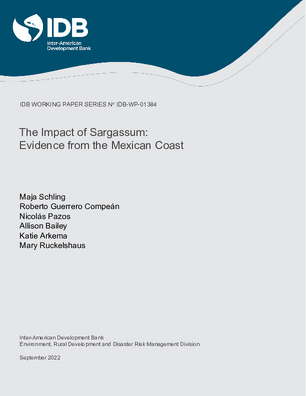The Economic Impact of Sargassum: Evidence from the Mexican Coast
Date
Sep 2022
This paper assesses the local economic impact of pelagic Sargassum seaweed washed ashore in tourism-heavy coastal zones in the Mexican State of Quintana Roo. The study relies on a carefully designed Geographic Information Systems (GIS) dataset of monthly observations from 2016 to 2019 for 157 beach segments. The dataset comprises an innovate measure of Sargassum seaweed presence, remotely sensed nighttime light intensity as a proxy of economic growth, as well as information on key infrastructure, sociodemographic and beach characteristics. We apply a fixed-effects regression model that controls for general time trends and unobserved, time-invariant differences across observations. We estimate that the presence of Sargassum in a beach segment reduces nighttime light intensity by 17.5%, representing an approximate 11.6% decrease in gross local product. Considering that impacts of Sargassum on local economic activity may be delayed due to reputational effects, our analysis finds that significant lagged effects can be detected up until 12 months after Sargassum was detected on the shoreline. These effect sizes range between a 5.9 and a 9.9% reduction in gross local product. Various robustness checks, including an adjusted measurement of Sargassum and the consideration of potential spatial correlation across beach segments, indicate that estimated impacts are consistently significant and negative across numerous specifications. For one of most tourism-dependent regions in the world, the recurrent influx is one of the most threatening manifestations of climate change. Our research is the first to robustly quantify the economic impact of Sargassum, and highlights the extent to which economic activity is negatively affected by the accumulation of seaweed and how these effects persist over time. The next important step is for both public and private sectors to invest in forecasting systems and containment strategies as well as engage in cleanup efforts to mitigate severe accumulations, inducing economic resilience in coastal communities.




